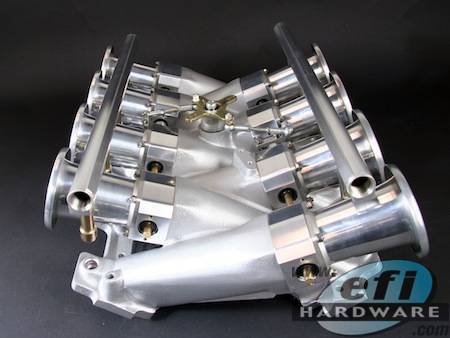

Because we have air filters, frictional losses in the intake system, and a throttle plate or butterfly that further restricts airflow, reduced pressure is created in the inlet manifold as the pistons try to draw air but are partially prevented from doing so. That means there is always at least one cylinder drawing air from the inlet manifold. There are usually two, four, six, or eight cylinders doing these four strokes, each slightly out of sync with the others. The fourth stroke in the cycle is the upstroke that forces the burnt gasses out of the cylinder, known as the exhaust stroke. Ignition occurs near the top of the compression stroke, heating the air and driving the piston down in the third expansion stroke. The up-stroke of that piston is called the compression stroke as it compresses the fuel-air mixture ready for ignition by the spark plug. It starts with an air intake stroke where outside air is sucked into the cylinder via the air intake manifold by the down-traveling piston. Four-stroke engines are called that due to the four cycles each cylinder performs.

To understand why the inlet manifold pressure is lower than ambient when the engine is running, we need to understand the four-stroke combustion cycle. When the engine is running, the pressure in the manifold drops below ambient.

The reading on the gauge will be close to or exactly the ambient air pressure when the engine is not running. The reading will be in inches of mercury (inHg) in the US or hectopascals (hPa) elsewhere. What is Manifold Pressure?Īircraft with a constant speed propeller has a manifold pressure gauge, or MAP gauge, that measures the air pressure within the inlet manifold. The device that delivers air, or fuel and air, to the engine cylinders to enable combustion. In this discussion on manifold pressure, we’re talking only about the inlet manifold. Some aircraft also have a fuel manifold that transfers fuel from the engine or fuel control unit to each cylinder. In addition to an inlet manifold, your aircraft engine will also have an exhaust manifold, which collects the exhaust from each cylinder and channels it to the muffler and exhaust system. You can see the six pipes branching off the furthest manifold and entering the six cylinders that it services. It then enters the manifold, where the air is distributed to the six cylinders closest to the cameraman. Note the air is fed in through the black plastic pipe near the bottom of the picture and passes through a control unit. The photo below shows the inlet manifolds for the Aston Martin V12 engine they’re the two silver castings on top of the engine. Turbocharged engines also use an inlet manifold, but it usually transfers only air, with the fuel being injected at each cylinder. Most normally aspirated engines have an inlet manifold that collects the air and fuel mixture from the carburetor and transfers it to each engine cylinder. On an engine, a manifold refers to a system of pipes that transfers liquid or gas from one inlet to multiple outlets or from multiple inlets to one output. What’s a Manifold?īefore we talk about the pressure within a manifold, it might be useful for some to understand what a manifold is. In this article, we’ll step through manifold pressure starting from the basics and moving through to some interesting advanced knowledge that may save your life one day. Any online search will give you a lot of information on manifold pressure, much of it difficult to understand, and some is simply wrong.
RACERENDER INTAKE MANIFOLD PRESSURE OBJECT HOW TO
When a pilot transitions from an aircraft with a fixed-pitch propeller to one with a constant-speed propeller, they need to get their head around the manifold pressure gauge, what it does, and how to use it.


 0 kommentar(er)
0 kommentar(er)
